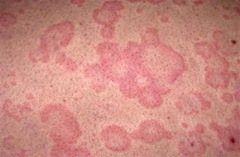Call Today to Schedule an Appointment: 212-319-5282
What are Hives?
NYC’s Top Allergist discusses Hives
 Hives are a rash that emerges as red, raised itchy bumps on the skin. The most commonly known cause of hives is an allergic reaction. They can also appear for unknown reasons. Hives are usually harmless, but they can sometimes be followed by another skin reaction called angioedema – swelling of deeper layers of skin. Angioedema can be possibly be life-threatening if it affects the tongue or throat and block the airways.
Hives are a rash that emerges as red, raised itchy bumps on the skin. The most commonly known cause of hives is an allergic reaction. They can also appear for unknown reasons. Hives are usually harmless, but they can sometimes be followed by another skin reaction called angioedema – swelling of deeper layers of skin. Angioedema can be possibly be life-threatening if it affects the tongue or throat and block the airways.
Hives are also known as urticaria. Hives can be classified in two forms: acute, which lasts for up to six weeks, and chronic, which lasts for more than six weeks.
Triggers of Hives
Hives can be caused by a number of different triggers. The most common causes of hives are allergens, such as:
- Medications: such as aspirin, ibuprofen, and blood pressure drugs
- Foods: such as peanuts, shellfish, tree nuts, eggs and milk
- Naturally occurring: such as pollen and animal material
Other common causes are environmental conditions, such as exposure to cold, heat, wind, sunlight, stress and even exercise. Dermatographia, which literally means “skin writing,” can also cause hives, and scratching the skin will produce skin redness in the form of the scratch. Chronic hives usually develop for an unknown cause, but they may also develop as an autoimmune response.
Symptoms of Hives
Hives appear with the following symptoms:
- Raised areas of the skin that are red in their base called wheals
- Itching and possibly burning skin
- If hives are followed by angioedema, the skin will swell and hurt
- In severe cases of angioedema, difficulty breathing or swallowing may be present
The common symptoms include wheals and itching. Wheals may go down and new ones may develop before the rash subsides, which makes it look like the condition is moving. Hives usually affect larger areas of the skin. A small percentage of people with acute hives, and about a half of people with chronic hives, will also have angioedema. Angioedema is a painful swelling of the inner layers of the skin. This can cause serious life-threatening health issues and obstruct breathing and swallowing.
Treatments for Hives
Treatment options for hives include:
- Antihistamines
- Oral corticosteroids
- Epinephrine in cases of severe angioedema
For acute hives caused by allergies, it’s important to determine the allergen and avoid it.
Antihistamines, both over-the-counter and prescribed by an allergy doctor, are the most effective treatment for mild to moderate cases of hives. More severe cases of hives are usually treated with oral corticosteroids, which reduce swelling and itching.
Cases of severe angioedema, especially if the swelling blocks the airways, have to be treated immediately with a shot of epinephrine to prevent worsening of the symptoms and death.
Serving all of New York City and the Tri State Area including Zip Codes: Top Allergist NYC Midtown, Chelsea and Clinton: 10001, 10011, 10018, 10019, 10020, 10036 | Gramercy Park and Murray Hill: 10010, 10016, 10017, 10022 | Greenwich Village and Soho: 10012, 10013, 10014 | Lower Manhattan: 10004, 10005, 10006, 10007, 10038, 10280 | Lower East Side: 10002, 10003, 10009 | Upper East Side: 10021, 10028, 10044, 10128 | Upper West Side: 10023, 10024, 10025
